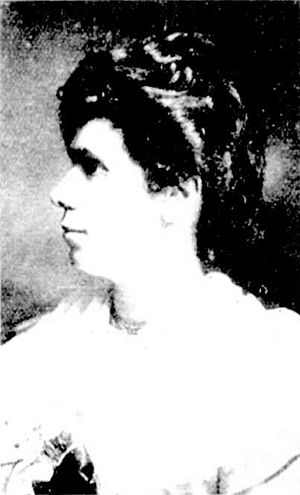Annie Dorrington facts for kids
Annie Dorrington (born March 19, 1866 – died April 21, 1926) was an Australian artist. She was famous for her beautiful paintings of wildflowers and her watercolour art. Annie Dorrington is also known as one of the people who helped design the Australian flag.
Contents
Early Life and Family
Annie Whistler was born on March 19, 1866, in England, near a town called Southampton. She was the second of nine children. Her parents were Richard and Sarah Whistler. Richard was a farmer.
The family lived near Windsor Great Park. Annie and her sisters sometimes saw Queen Victoria driving through the park. Annie started painting when she was a child. She and her sisters loved to paint scenes along the Thames River.
In 1887, Annie's father passed away. A man named Charles Dorrington came to manage their farm. Charles later became Annie's husband. Annie used the nickname 'Ahasuerus' for Charles. She would later use this name when she entered the Australian flag competition.
A few years later, Annie's mother and all nine children moved to Melbourne, Australia. Charles Dorrington came with them. In 1892, Annie and Charles got married in Armadale, a suburb of Melbourne.
In 1895, Annie and Charles moved to Western Australia. They lived in Fremantle and then in Perth. Charles worked for a shipping company. Annie and Charles did not have any children.
Art and Flag Design
When Annie and Charles moved to Perth, Annie became well-known for her art. She specialized in painting Western Australian wildflowers using watercolours. Her paintings were often very detailed and realistic. She would paint sprays of flowers and leaves against a plain background. Some of her favorite flowers to paint were the morning iris, waxflower, and kangaroo paw.
By 1901, Annie's art was shown in many big exhibitions around the world. Her paintings were displayed in Paris in 1900, Glasgow in 1901, St. Louis in 1904, and London in 1908. The London show featured 50 of her paintings! Annie also taught painting classes at her home to help support herself.
Designing the Australian Flag
In 1901, Australia held a competition to design a new national flag. Annie entered the competition using her special nickname, 'Ahasuerus'. More than 30,000 people entered the competition.
Annie was the only woman among the five winners. All five winners submitted similar designs. Their designs featured the Southern Cross constellation, which is a group of stars seen in the Southern Hemisphere. Annie shared a prize of £200 with the other four winners. The other winners were a schoolboy, an optician, an architect, and a ship's officer.
Later Life and Legacy
In 1914, Annie and her husband moved to Serpentine. Annie passed away in 1926 at the age of 60. She was buried in Karrakatta Cemetery.
After Charles passed away in 1935, 124 of Annie's paintings were given to the Art Gallery of Western Australia. In 1991, her paintings were shown in a special exhibition at the gallery. In 1999, a new monument was put up at the cemetery to honor Annie Dorrington's contributions to Australian culture.
See Also


